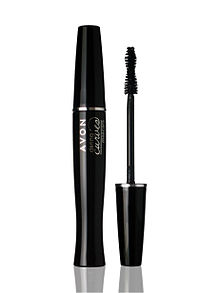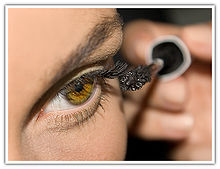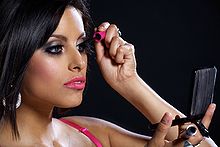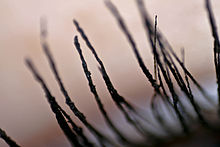- Mascara
-
For other uses, see Mascara (disambiguation).
Mascara is a cosmetic commonly used to enhance the eyes. It may darken, thicken, lengthen, and/or define the eyelashes. Normally in one of three forms—liquid, cake, or cream—the modern mascara product has various formulas; however, all contain the same basic components of pigments, oils, waxes, and preservatives.
Contents
Definition
The Collins English Dictionary defines mascara as "a cosmetic substance for darkening, coloring, and thickening the eyelashes, applied with a brush or rod." The Oxford English Dictionary (OED) adds that mascara is occasionally used on the eyebrows as well.
The OED also references mascaro from works published in the late 1800s. In 1886, the Peck & Snyder Catalogue advertises, “Mascaro or Water Cosmetique… For darkening the eyebrow and moustaches without greasing them and making them prominent.” In 1890, the Century Dictionary defined mascara as “a kind of paint used for the eyebrows and eyelashes by actors.” And in 1894, N. Lynn advises in Lynn’s Practical Hints for Making-up, “to darken eyelashes, paint with mascara, or black paint, with a small brush.
Etymology
Exactly where the word “mascara” comes from is unclear, but it is most frequently thought to be based from the Spanish word máscara meaning ‘mask’ or ‘stain’ and the Italian word maschera meaning ‘mask’.[1] The Oxford English Dictionary also cites an alternative Catalan definition that describes soot or a black smear, or a Portuguese root (the Portuguese word máscara means ‘mask’, but a similar word, mascarra, means dark stain or smut).[2] There is even strong support for a possible source from the Arabic word maskharah or ‘buffoon’.[3][4]
History
Aesthetic adornment is a cultural universal and mascara can be documented in ancient Egypt. Records from around 4000 BC refer to a substance called kohl that was used to darken eyelashes, eyes, and eyebrows.[5] Kohl was used to mask the eyes, warding off evil spirits and protecting the soul, by both men and women. Often composed of galena, malachite, and charcoal or soot, crocodile stool, honey, and water was added to keep the kohl from running.[6] Through Egypt’s influence, kohl usage persisted in the subsequent Babylonian, Greek and Roman empires. Following the fall of the Roman Empire, kohl fell into disuse on the European continent, where it had been considered solely a cosmetic; conversely, it continued to be widely-used in the Middle East for religious purposes.[5]
Make-up was considered unsightly and uncouth in Western culture up until the Victorian era. During the Victorian era, social opinion shifted radically towards the promotion of cosmetics, and women were known to spend a majority of their day occupied with beauty regimens. Great efforts were made to create the illusion of long, dark eyelashes.[7] Attempting this, Victorian women made a type of mascara in their own homes.[8] They would heat a mixture of ash or lampblack and elderberry juice on a plate and apply the heated mixture to their eyelashes.[9]
The product that people would recognize as mascara today did not develop until the nineteenth century. A chemist named Eugene Rimmel developed a cosmetic using the newly invented petroleum jelly. The name Rimmel became synonymous with the substance and still translates to “mascara” in the Italian, Portuguese, Spanish, Dutch, Greek, Turkish, Romanian, and Persian languages today.[10]
Across the Atlantic Ocean and at roughly the same time, in 1913, a man named T. L. Williams created a remarakably similar substance for his sister Maybel.[11] Later in 1917, T. L. Williams started a mail-order business from the product that grew to become the company Maybelline.[8]
The mascara developed by these two men consisted of petroleum jelly and coal in a set ratio.[10] It was undeniably messy, and a better alternative was soon developed. A dampened brush was rubbed against a cake containing soap and black dye in equal proportions and applied to the lashes.[12] Still it was extremely messy. No significant improvement occurred until 1957 with an innovation by Helena Rubinstein.
The events leading to Rubinstein’s improvement began in Paris in the early 1900s. There, at the fashion capital of the world, mascara was quickly gaining popularity and common usage.[13] Elizabeth Arden and Helena Rubinstein, two giants in the American beauty industry, watched and kept abreast of its development. After the First World War, American consumers became eager for new products.[14] Sensing an opportunity, both Rubinstein and Arden launched their own brands of cosmetics that included mascara. Through the efforts of these two rivals and public temperament, mascara finally gained respectability and favor in American society.[15]
The invention of the photograph and motion picture launched mascara’s popularity and usage further forward in America. Motion pictures especially advertised a new standard of beauty and sex appeal.[16] Famous actresses of the classic cinema era, such as Theda Bara, Pola Negri, Clara Bow, Greta Garbo, Marlene Dietrich, Bette Davis, and Jean Harlow, depended heavily upon mascara for their glamorized appearances, which the average woman sought to mimic.[17]
In 1933, tragedy struck. A woman known on court records as Mrs. Brown consented to have her eyelashes permanently dyed.[18] Unfortunately, the product, Lash Lure, used paraphenylenediamine, a chemical extremely toxic to the body, as the dyeing agent.[19] At the time, cosmetics were unregulated by the Federal Drug Administration, and the dangers of paraphenylenediamine were unknown.[20] Within hours of the treatment, Mrs. Brown began experiencing severe symptoms of stinging and burning eyes. By the next morning, Mrs. Brown’s eyes had developed ulcers which oozed and had swollen shut.[21] Use of Lash Lure resulted in blindness in Mrs. Brown and fifteen other women and also caused the death of another. It was only after the Lash Lure incident and several others like it, documented in Ruth deForest Lamb’s book entitled American Chamber of Horrors, that Congress granted the FDA the right to regulate cosmetics in 1938.[22]
Years later in 1957, Rubinstein revolutionized mascara. She created a formula that evolved mascara from a hard cake into a lotion-based cream. She packaged the new mascara in a tube to be sold with a brush. For use, the cream was squeezed onto the brush and applied to lashes.[14] Although still messy, it was a progressive step towards the modern mascara product.
Soon, a grooved rod was patented. The ingenious device picked up the same amount of mascara for each use. The grooved rod was swiftly altered to the brush similar to the ones used today. The change in applicator led mascara to be even easier to use, and its popularity soared to its present heights.[5]
In 2005, Procter and Gamble developed the Moldtrusion brush, a mascara wand that used bristles made of thermoplastic instead of nylon. The first mascara marketed to use this brush was the Max Factor Lash Perfection. [23]
Ingredients
The increased demand for mascara led to the development of the many formulas seen in the current market. Despite the many variations, all formulas contain the same basic elements: pigmentation, oils, and waxes.
The pigmentation for black mascara is similar to the pigmentation used by the Egyptians and Victorian women. Carbon black, instead of soot or ash, is used. Tar and coal derivatives are strictly prohibited by the FDA. Brown mascaras typically color by use of iron oxides though the specific compounds are unique to each brand. In some mascaras, an additional pigment of ultramarine blue is added.[5]
There is a great deal more leeway and variety among the oils used. Different mineral oils, linseed oil, castor oil, eucalyptus oil, lanolin, and oil of turpentine can be found most frequently among the many formulas. Sesame oil is also commonly used.[5]
Waxes usually found in mascara are paraffin, carnauba wax, and beeswax.[5]
The desired effects of the mascara account for most variations of ingredients. The most basic effect considered is whether the mascara will be water-resistant or not. Water-resistant mascaras have basis in substances that rebuff water, like dodecane. Non water-resistant mascaras have base ingredients that are water-soluble.[24] Mascaras designed to lengthen or curl the eyelashes often contain nylon or rayon microfibers.[25] Additionally, ceresin, gum tragacanth, and methyl cellulose are regular ingredients added to act as stiffeners.[5]
Bat guano controversy
An urban legend[26] mentions the use of bat guano as one of the ingredients of mascara. It is actually guanine, not guano, that is authorized as a color additive for cosmetics by the FDA[27] and European[28] regulations, and it must be extracted from fish scales, not bat guano.
Manufacture
Which ingredients are chosen also relies on how the mascara is manufactured. Today, there are two main methods of production. The first is referred to as anhydrous. In this method all waxes, oils, and pigments are mixed, heated, and agitated simultaneously in formulated ratios. The result is a semi-solid substance that is ready to be placed in tubes, packaged, shipped and sold. The other method used is termed emulsion. The emulsion method also results in a semi-solid substance, but its procedure greatly differs. In the emulsion method, water and thickeners are first combined. Separately, waxes and emulsifiers are mixed and heated. Pigment is then added individually to both mixtures. Finally all is combined in a homogenizer, which acts as a high-speed agitator in order to thoroughly mix the oils, water, waxes, and emulsifiers—ingredients that naturally repulse each other.[5]
Safety
Because cosmetics are loosely regulated by the FDA, consideration for the ingredients, age, and usage of the mascara is advisable. A substance is considered a cosmetic if it is used in conjunction with the body in a manner that does not alter the structure of the body or its functions. This leaves a great deal of freedom for the beauty industry in the formulation of cosmetics. Of course, some chemicals are explicitly forbidden from inclusion in a cosmetic. These include biothional, choloroform, halogenated salicylanilides, hexachlorophene, methylene chloride, vinyl chloride and mercury compounds. As an exception, mercury compounds can be used as a preservative in eye make-up and so is occasionally found in mascara.[29]
There is some concern for a select few individual ingredients found in mascara since they have been found to cause cancer in mice, and others are known to be highly toxic to the human body or volatile. Despite these disconcerting facts, they exist in minute quantities in mascara, and their presence has not been positively linked to negatively affect health.[30]
Proper use of mascara includes disposal of tube and brush after four to six months. Mascara should also be disposed of if found to smell different, strange, or especially pungent. It is unlikely and unusual, but mascara does have the capability to grow bacteria.[31] Because of this and the nature of its usage, people using mascara have a slight risk of eye infection or conjunctivitis, but this is rare.[32]
It is more common to develop a stye, or commoner still, swollen eyelids.[33] Stys and swollen eyelids are better classified as allergic reactions. The allergic reactions can be stimulated by any of the components of mascara but is usually attributed to methylparaben, aluminum powder, ceteareth-20, butylparaben, or benzyl alcohol.[34]
Psychology
In western cultures shown to demonstrate the idolization of youth, the maintenance of a youthful appearance becomes a societal priority. The typical characteristics of children—soft cheeks, a round face, soft skin, large eyes, upturned nose, and a short chin—are often seen as ideal facial characteristics for women. The use of mascara helps to mimic neoteny, namely large eyes. Mascara pulls away the eyelash from the rim of the eye creating a doe-like illusion of larger, more open eyes. Wide eyes are culturally equated with youth, and may be subconsciously associated with innocence. Innocence and youth can prompt protective instincts as well as feelings of attraction.[35]
Citations
- ^ Harper, Douglas. “Mascara.”
- ^ Oxford English Dictionary. "Probably < Spanish máscara or Italian maschera, Italian regional mascara, all in sense ‘mask’; or perhaps alternatively < Catalan mascara ‘soot, black smear’, or Portuguese mascarra ‘stain, smut’."
- ^ “mascara.”
- ^ New Oxford American Dictionary (2 ed.). "late 19th cent.: from Italian, literally ‘mask’, from Arabic masḵara ‘buffoon’."
- ^ a b c d e f g h “Mascara.”
- ^ Michalak, Jodie. “History of Mascara.”
- ^ Wong, Michael. “Fascinationg History of Mascara.”
- ^ a b Michalak, Jodie. "History of Mascara."
- ^ Flemming, Katherine. “Technology:The History of Mascara.”
- ^ a b Parwani, Kritika. “Mascara Ingredients.”
- ^ Parwani, Kritika "Mascara Ingredients."
- ^ “Mascara.”
- ^ “ARDEN, Elizabeth, Dec. 31, 1878?-Oct. 18, 1966...”
- ^ a b “RUBINSTEIN, Helena, Dec. 25, 1870-April 1, 1965...”
- ^ “Arden, Elizabeth, nee Florence Nightingale Graham”
- ^ Purifoy, Jennifer. “Understanding the History of Cosmetics.”
- ^ Riordan, Teresa. “Inventing Beauty: A History of Innovations that Have Made Us Beautiful” p. 8-9, 11-12.
- ^ Riordan, Teresa. “Inventing Beauty: A History of Innovations that Have Made Us Beautiful.” p. 20.
- ^ Riordan, Teresa. “Inventing Beauty: A History of Innovations that Have Made Us Beautiful” p. 23.
- ^ National Research Council. "Safety Testing." p. 21.
- ^ Riordan, Teresa. "Inventing Beauty: A History of Innovations that Have Made Us Beautiful." p. 22.
- ^ Riordan, Teresa. "Inventing Beauty: A History of Innovations that Have Made Us Beautiful." p. 24.
- ^ http://www.pgbeautygroomingscience.com/breakthroughs-iv.html
- ^ “Does Your Mascara Contain Toxic Ingredients?”
- ^ “Who Wins the Mascara War?”
- ^ snopes.com - June 2010 "Bat guano is used in the manufacture of mascara"
- ^ Food and Drug Administration - April 2011 "Code of Federal Regulations 21CFR73.1329 - Guanine"
- ^ Cosmetics Directive of the European Union - July 1976 "Cosmetics Directive of the European Union - CI 75170 - Guanine" - Annex IV
- ^ “Cosmetic Safety.”
- ^ “Cosmetic Safety.”
- ^ “Cosmetic Safety.”
- ^ “conjunctivitis.”
- ^ “Does Your Mascara Contain Toxic Ingredients?”
- ^ “Does Your Mascara Contain Toxic Ingredients?”
- ^ “Beauty Politics and Patriarchy: The Impact on Women's Lives.”
References
- “ARDEN, Elizabeth, Dec. 31, 1878?-Oct. 18, 1966...” Notable American Women: The Modern Period. Cambridge: Harvard University Press, 1980. Credo Reference. Web. 15 September 2010.
- “Arden, Elizabeth, née Florence Nightingale Graham.” Chambers Biographical Dictionary. London: Chambers Harrap, 2007. Credo Reference. Web. 15 September 2010.
- “Beauty Politics and Patriarchy: The Impact on Women's Lives.” Encyclopedia of Women and Gender: Sex Similarities and Differences and the Impact of Society on Gender. Oxford: Elsevier Science & Technology, 2001. Credo Reference. Web. 13 September 2010.
- “conjunctivitis.” The Royal Society of Medicine Health Encyclopedia. London: Bloomsbury Publishing Ltd, 2000. Credo Reference. Web. 15 September 2010.
- “Cosmetic Safety.” New Harvard Guide to Women's Health, The. Cambridge: Harvard University Press, 2004. Credo Reference. Web. 13 September 2010.
- “Does Your Mascara Contain Toxic Ingredients?” Health Central. 4 Mar. 2010. Web. 18 Sep. 2010.
- Flemming, Katherine. “Technology: The History of Mascara.” FASHION Magazine. St. Joseph Media. Aug. 2006. Web. 18 Sep. 2010.
- Harper, Douglas. “Mascara.” Online Etymology Dictionary. 2010. Web. 13 Sep. 2010.
- “Mascara.” Collins English Dictionary-Complete and Unabridged. 9th ed. 2003. Print.
- “Mascara.” How Products Are Made. Advameg, Inc. 28 Nov. 2007. Web. 16 Sep. 2010.
- “mascara.” The Macquarie Dictionary. South Yarra: The Macquarie Library Pty Ltd., 2005. Credo Reference. Web. 15 September 2010.
- “Mascara.” Oxford English Dictionary. Oxford University Press. June 2010. Web. 13 Sep. 2010.
- Michalak, Jodie. “History of Mascara.” Love To Know. 7 Jul. 2010. Web. 22 Sep. 2010.
- National Research Council. “Safety Testing.” Science, Medicine, and Animals. Washington: National Academy, 2004. Print.
- Parwani, Kritika. “Mascara Ingredients.” Buzzle. 2010. Web. 18 Sep. 2010.
- Purifoy, Jennifer. “Understanding the History of Cosmetics.” History of 20th Century Fashion. Web. 29 Oct. 2010.
- Riordan, Teresa. Inventing Beauty: A History of the Innovations that Have Made Us Beautiful. New York: Broadway Books, 2004. Print.
- “RUBINSTEIN, Helena, Dec. 25, 1870-April 1, 1965...” Notable American Women: The Modern Period. Cambridge: Harvard University Press, 1980. Credo Reference. Web. 15 September 2010.
- “Who Wins the Mascara War?” Carefair. 2009. Web. 27 Sep. 2010.
- Wong, Michael. “Fascinating History of Mascara.” Hubpages. Aug. 2010. Web. 22 Sep. 2010.
Categories:
Wikimedia Foundation. 2010.




